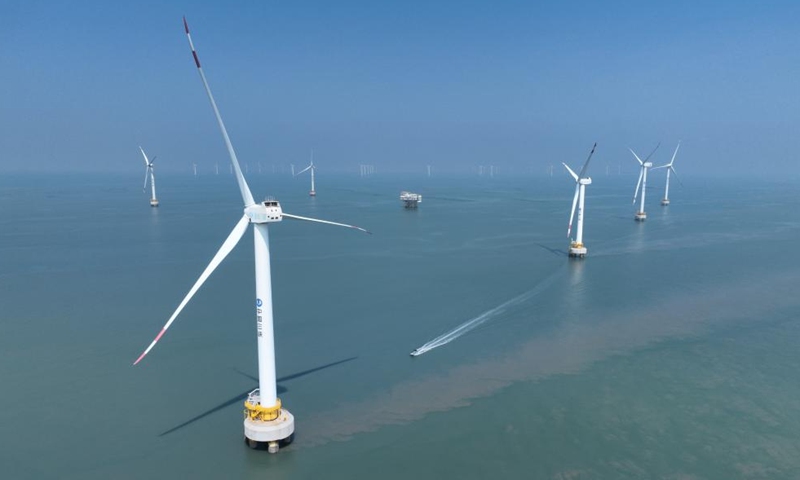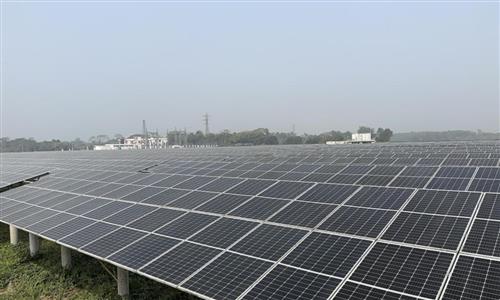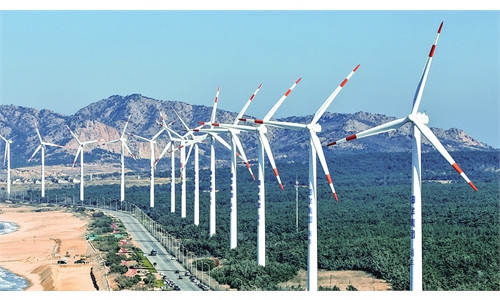Stock market, industry upbeat on China's green transition efforts
Guidelines to boost China’s high-quality development: experts

An aerial drone photo taken on Aug. 8, 2024 shows the Xinghua Bay pilot wind farm where some offshore wind turbines independently produced in Fujian Three Gorges Offshore Wind Power International Industrial Park are installed in Fuqing City, southeast China's Fujian Province. The industrial park, with a total investment of 4 billion yuan (about 557.7 million U.S. dollars), is the first full-industry-chain offshore wind power industrial park in China. (Photo: Xinhua)
The unveiling of China's guidelines to ramp up its green transition has sparked a warm response from both the stock market and industry insiders, with shares related to environmental protection surging on Monday.
Experts believe that the guidelines, released on Sunday, outline specific green goals and tasks, providing a clear direction for future green development and promoting China's high-quality development.
Shares in the environmental protection sector rose 2.3 percent overall on Monday, with 91 stocks experiencing gains. Hydrogen energy concept stocks saw a surge in the afternoon, with companies like Houpu Clean Energy Group rising by more than 10 percent.
Insiders in the environmental protection and new-energy industries are optimistic about the development opportunities presented by the guidelines, which aim to ramp up the green transition in all areas of economic and social development.
"We are embracing the development of solar energy as highlighted in the guidelines, in particular the development of solar energy along highways," Feng Chao, general manager of a Zhengzhou-based energy company, told the Global Times on Monday.
Executives at Urumqi Huayuan Thermal Power Co expressed optimism about the guidelines, stating that they would offer a great lift to the industry and help reduce carbon emissions in the heating sector.
"After the guidelines were unveiled, we wasted no time in diving into the preliminary work. We are actively studying the policy content, and two related projects are already underway," said Peng Jun, general manager of the company, told the Global Times on Monday.
The company is also looking forward to the specific incentives that will be introduced, such as financial, tax, funding and credit support, to facilitate innovation in the sector, Peng said.
According to the guidelines, the main objectives are that by 2030, the country will achieve "remarkable results" in the green transition in all areas of economic and social development; and by 2035, a green, low-carbon, and circular development economic system will be basically established and the goal of Beautiful China will be basically achieved.
The guidelines also put forward quantitative work goals for different fields. By 2030, the scale of the energy conservation and environmental protection industry in the country will reach about 15 trillion yuan ($2.1 trillion), the proportion of non-fossil energy will increase to about 25 percent of energy consumption, and the installed capacity of pumped storage hydropower will exceed 120 million kilowatts, the Xinhua News Agency reported.
"Green development is a major direction for high-quality economic growth. The guidelines set out many specific green goals and tasks, providing a clear direction for green development," Liu Jiaqi, a professor of environmental policy at Liaoning University, told the Global Times on Monday.
According to the guidelines, the country will pursue fiscal and taxation policies that are conducive to promoting green and low-carbon development and the efficient use of resources, Xinhua reported.
"By incentivizing investments in green industries and technologies, these policies can effectively guide market resources toward sustainable practices. As society increasingly prioritizes environmental protection and sustainable development, the demand for green industries and technologies is expected to continue growing," Wang Peng, an associate research fellow at the Beijing Academy of Social Sciences, told the Global Times on Monday.



